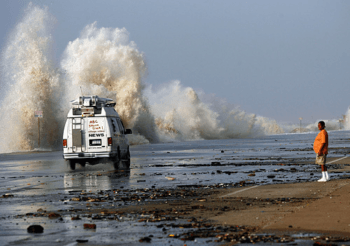The Ike Dike: A Solution For Saving Lives And Preventing Storm Damage

Hurricane Ike’s death and destruction vividly pointed out the need for protection from hurricane storm surge in the Houston-Galveston region.
“And, as bad as Ike was, we who live and work around Galveston Bay dodged a bullet,” said Dr. William “Bill” Merrell, the George P. Mitchell Chair of Marine Sciences at Texas A&M at Galveston.
Before Ike hit, the forecast predicted a 25 foot storm surges up Galveston Bay — a possible $100 billion hurricane, which could have killed hundreds, left thousands homeless and jobless and devastated the nation’s largest petrochemical complex and crippled its busiest port.
Merrell says this terrible scenario can be prevented, and he has created the Ike Dike solution based on best practices for preventing storm surge damage developed by the Dutch.
Dialogues with Dutch experts helped in the development of the flood protection system in New Orleans that performed well during Hurricane Isaac. Merrell has developed a similar solution for the entire Galveston Bay area called the “Ike Dike.”
“We at Texas A&M University at Galveston have been privileged to work with Dutch institutions and other strong partners to better understand how to protect our region’s people, economy and environment from hurricane induced storm surge,” Merrell says.
Netherlands Ambassador Rudolf Bekink commented about sharing flood protection technology.
“The Netherlands and the United States share similar water-related challenges,” Bekink explains. “Techniques used in the Netherlands are being adapted in Louisiana, California, Florida and New York. We look forward to working with Galveston on strengthening the flood protection systems of the Galveston Bay area.”

Merrell wants to use those proven Dutch techniques.
“We can apply best practices and existing technologies used in the Netherlands and New Orleans to protect our region,” he says. “The coastal spine concept is the approach the Dutch used after their 1953 surge disaster. They shortened their coast by combining barriers and gates to keep surge out of internal waters. We are using that same knowledge as a solution to protect the Galveston-Houston area.”
To obtain the latest practices and technologies employed by the Dutch, Texas A&M at Galveston officials recently led a delegation of 29 business owners, economists, elected officials, port representatives and educators from the Galveston Bay area to tour flood-control projects in the Netherlands.
The visit, organized by TAMUG, the Royal Netherlands Embassy and the Netherlands Business Support Office in Houston, was designed to give participants firsthand information about possible solutions to the recurring surge issue faced by all who reside and work on Galveston Bay.
The delegation was led by Rear Admiral Robert Smith III, Texas A&M Galveston President, and Merrell.
Admiral Smith III pointed to the importance of storm surge protection.

“Given the economic importance of the Galveston Bay region to Texas and the nation, coastal surge protection is the most important public policy issue for Texas,” Smith says. We are grateful to our Dutch friends for the opportunity to see the best practices.”
This visit to the Netherlands provided the members of the delegation with more detailed information.
Sixty percent of the Netherlands is at or below sea level and two-thirds of Dutch people live in flood-prone areas. The Dutch possess more than 800 years of water management experience. During the visit, the group observed many elements that comprise the Dutch water management system including:
- The annual test closing exercise of the massive Maeslant Storm Surge Barrier;
- Viewing the Sand Motor project that replenishes the coast, which is constantly eroded by North Sea currents;
- Tours of Eastern Scheldt Surge Barrier, the Maasvlakte 2 Port of Rotterdam extension project, a coastal dune and sea-front boulevard restoration project, Delft Technical University and Deltares.
To learn more about the environmentally friendly, socially relevant efforts to use the proven technologies of the Ike Dike concept to prevent major storm surges, contact William Merrell.
Media contact: tamunews@tamu.edu.





